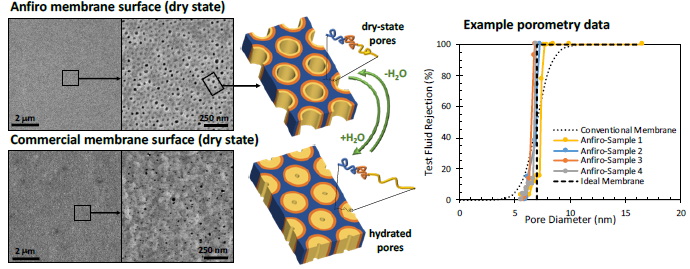Grantee Research Project Results
Final Report: Block Copolymer Membranes for Total Removal of Ionic and NonionicPFASfrom Industrial Wastewaters Optionally Co-Contaminated by Alcohols
EPA Contract Number: 68HERD19C0013Title: Block Copolymer Membranes for Total Removal of Ionic and NonionicPFASfrom Industrial Wastewaters Optionally Co-Contaminated by Alcohols
Investigators: Holmberg, Angela
Small Business: Anfiro, Inc.
EPA Contact: Richards, April
Phase: I
Project Period: May 1, 2019 through October 31, 2019
Project Amount: $100,000
RFA: Small Business Innovation Research (SBIR) - Phase I (2019) RFA Text | Recipients Lists
Research Category: SBIR - Water Quality , Small Business Innovation Research (SBIR) , Small Business Innovation Research (SBIR): Phase 1 (2019)
Description:
The EPA aims to reduce the total concentration of poly- and perfluoroalkyl substances (PFAS) in wastewater to <70 ppt, yet few treatment methods are capable of removing both long-chain and short-chain PFAS efficiently. As companies tweak the chemical structures of their fluorochemicals, the landscape of PFAS is also continually changing, and not all treatment technologies can keep up. Some that might meet these challenges include reverse osmosis (RO) and tight nanofiltration (NF) membranes; however, they generally require high operating pressures or fail when exposed to alcohols. These shortcomings render existing commercial NF and RO membranes impractical for treating alcohol-contaminated wastewaters, such as those from semiconductor industries.
Anfiro is manufacturing a novel block copolymer (BCP) membrane with uniquely uniform pores (see Figure), excellent resistance to alcohols and chlorine, and higher permeabilities relative to RO membranes. The performance is NF-like but with sharper size-based rejection performance. The technology has many other benefits as well. The envisioned membrane modules are to be sized for installation as drop-in-replacements, and the manufacturing protocols include low-input, low-waste polymerization methods and conventional, continuous roll-to-roll processing. Product manufacturing costs are also expected to be similar to those for existing NF membranes. These features motivated the work of this project—benchmarking the performance of Anfiro’s BCP technology for PFAS sequestration. The results were needed to evaluate whether the realm of PFAS sequestration might be a viable early market for Anfiro’s innovative separation technology.
Summary/Accomplishments (Outputs/Outcomes):
The results of the benchmarking tests were promising. The best-performing formulation had a permeability of 10.5 ± 1.3 L/m2·h·bar that was stable over eight weeks of exposure to isopropyl alcohol (IPA), and the membrane structure was unchanged throughout that time. This result starkly contrasts that for commercial RO membranes, which rapidly become impermeable in 5% IPA. The dead-end stirred-cell rejection performance was also high. The individual solute rejections were 70–93% for short-chain PFAS (PFBA, PFBS, and GenX) and 86 to >99% for long-chain PFAS (PFOA, PFOS, and ADONA). The total PFAS rejection exceeded 90% for 100-200 ppb mixed-PFAS feeds, noting that half of the PFAS in the mixture were of the increasingly common but hard-to-capture short-chain types. The percent PFAS retention was independent of concentration yet increased with water flux. For the tested concentrations, the PFAS removal mechanism was dominated by retention but somewhat attributable to binding, especially for the PFAS with sulfonate functionalities. All of these results are informative as to how the technology might fit into a PFAS treatment train.
Conclusions:
The IPA stability and decent rejection performance supports that Anfiro’s technology might operate successfully for removing PFAS from IPA-contaminated wastewater, such as those from semiconductor industries. However, the fact that the membranes bind certain PFAS reduces their viability for recovering and recycling PFAS as was initially proposed. The PFAS-binding characteristics impact considerations for cleaning and disposing membrane products and a potential need for evaluating breakthrough performance. These realizations, plus further customer discovery and market research activities, motivate a change in approach. Anfiro’s membrane may be best suited to improving the performance of a complete sequestration-and-destruction treatment train. That said, permeability-and-rejection performance means little without quantifying how increasing concentration and changing the stream compositions impacts downstream PFAS-treatment processes, so more information on the performance of non-membrane technologies is needed.
The perspectives, information and conclusions conveyed in research project abstracts, progress reports, final reports, journal abstracts and journal publications convey the viewpoints of the principal investigator and may not represent the views and policies of ORD and EPA. Conclusions drawn by the principal investigators have not been reviewed by the Agency.

